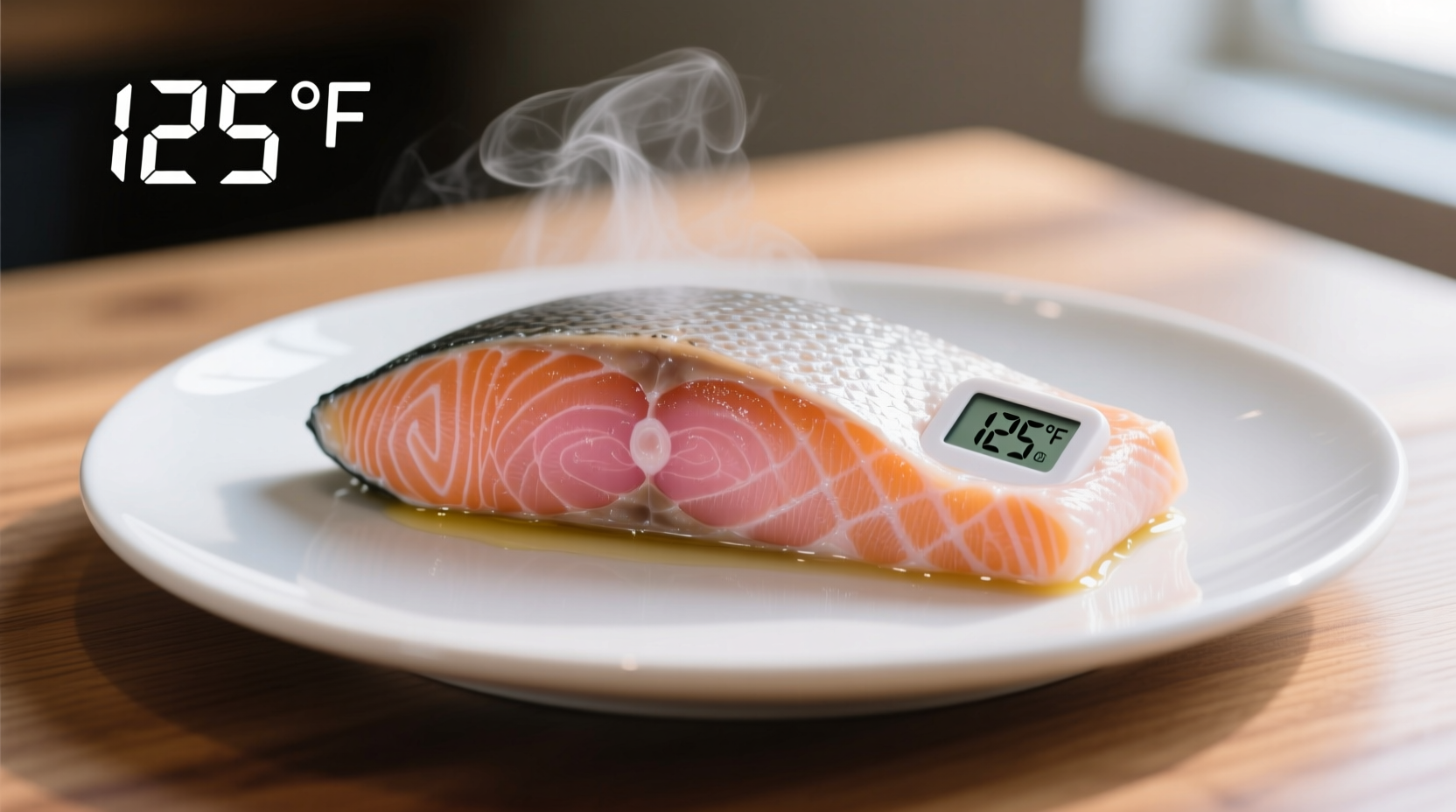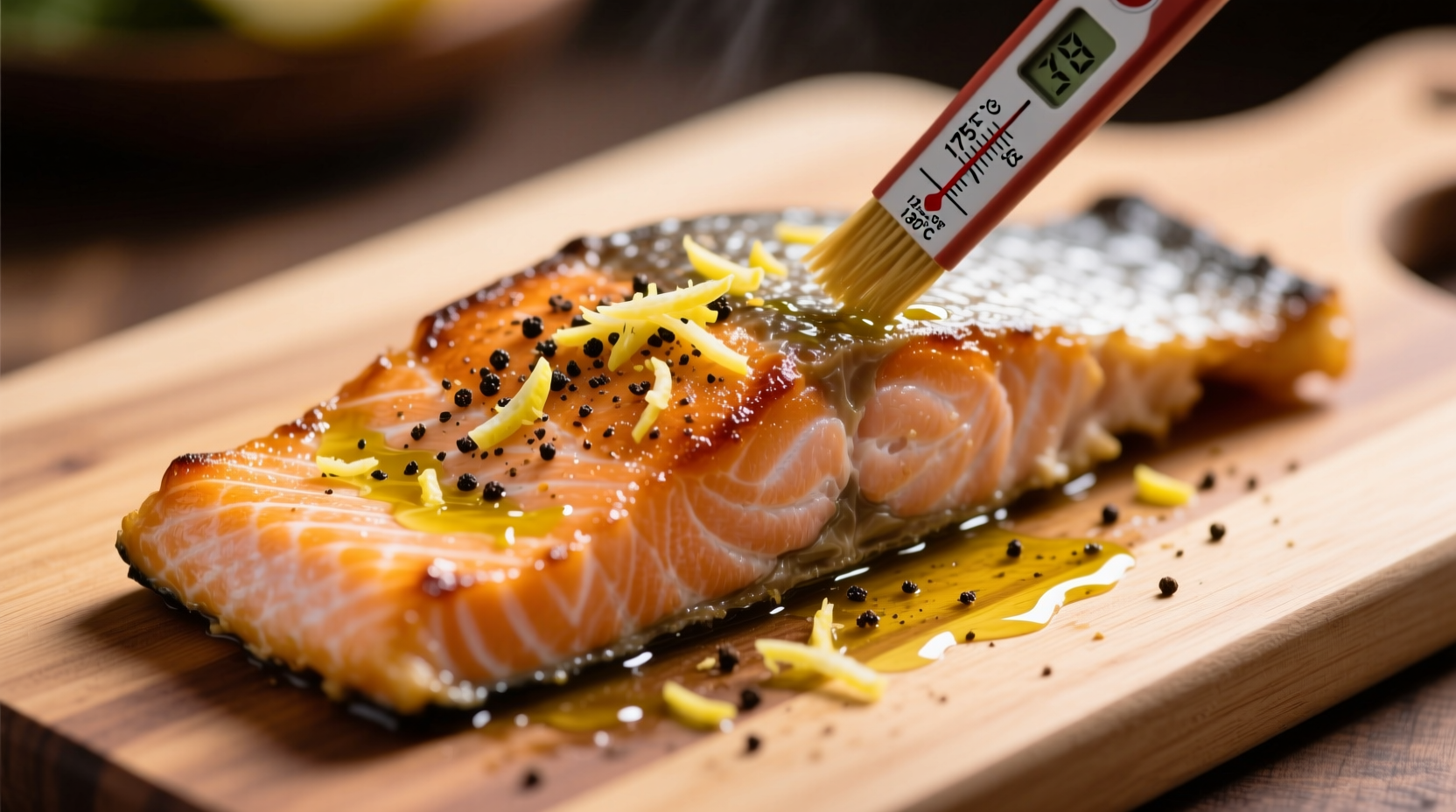Why Temperature Matters More Than Time for Perfect Salmon
Unlike many proteins where cooking time is the primary guide, salmon's delicate texture makes internal temperature the most reliable indicator of doneness. Fish proteins denature rapidly above 120°F, causing moisture loss that leads to dry, chalky results when overcooked. The precise temperature you target determines whether your salmon will have that coveted buttery, moist texture or become dry and flaky.
Salmon Temperature Guide by Desired Doneness
| Doneness Level | Internal Temperature | Texture Characteristics | Resting Time |
|---|---|---|---|
| Rare | 120-125°F (49-52°C) | Translucent center, very soft texture | 3-5 minutes |
| Medium-rare | 125-130°F (52-54°C) | Slightly translucent center, rich and buttery | 5 minutes |
| Medium | 130-135°F (54-57°C) | Opaque but still moist throughout | 5-7 minutes |
| Medium-well | 135-140°F (57-60°C) | Firm but not dry, minimal translucency | 7 minutes |
| Well-done | 140-145°F (60-63°C) | Fully opaque, flaky texture | 7-10 minutes |
USDA Safety Guidelines vs. Culinary Best Practices
The USDA Food Safety and Inspection Service recommends cooking fish to a minimum internal temperature of 145°F (63°C), measured with a food thermometer. However, this temperature often produces salmon that many chefs consider overcooked. America's Test Kitchen research shows that salmon continues to cook 5-10 degrees after removal from heat during the resting period—a phenomenon known as carryover cooking.
For optimal results, most professional chefs recommend removing salmon from heat at 125-130°F for medium-rare doneness, allowing it to reach 130-135°F during resting. This approach maintains moisture while still meeting safety standards for healthy adults, as salmon's primary food safety concern (parasites) is eliminated at 120°F for 15 minutes according to FDA guidelines.
How to Measure Temperature Accurately
Proper thermometer placement is critical for accurate readings:
- Insert your instant-read thermometer into the thickest part of the fillet
- Aim for the center, avoiding contact with the pan or baking sheet
- Take multiple readings if the fillet has uneven thickness
- Check temperature 2-3 minutes before expected doneness time
Thermometer type matters—digital instant-read thermometers provide the most accurate results for thin fish fillets. Leave-in probes work well for thicker cuts or whole fish but may not register the precise moment you need to remove salmon from heat.

Cooking Method Temperature Adjustments
Different cooking methods require slight temperature adjustments:
Oven Baking
Preheat to 375-400°F (190-205°C). For 1-inch thick fillets, bake 12-15 minutes until reaching target internal temperature. Higher oven temperatures (425°F+) create better surface browning but require closer temperature monitoring.
Pan-Seared
Heat oil to shimmering point (around 350°F/175°C) before adding salmon skin-side down. Cook 6-8 minutes skin-side down, then 2-3 minutes flesh-side down. The USDA verifies that proper searing technique creates a food-safe crust while allowing lower internal temperatures.
Grilling
Maintain medium heat (350-400°F/175-205°C). Place salmon skin-side up directly on grates. Grill 6-8 minutes until fish releases naturally from grates, then check temperature. The Food Safety and Inspection Service notes that grill marks don't indicate doneness—only thermometer readings do.
Resting: The Critical Final Step
Never skip resting time—this allows heat distribution and protein relaxation. During the 5-7 minute rest:
- Temperature rises 5-10°F (carryover cooking)
- Moisture redistributes throughout the fillet
- Flesh firms to perfect flakiness without drying
Cover loosely with foil to retain heat but prevent steaming, which would soften the crust. For best results, rest on a wire rack rather than a plate to prevent bottom sogginess.
Troubleshooting Common Temperature Issues
Problem: Salmon appears cooked but registers below 120°F
Solution: Your thermometer may be inaccurate—calibrate it in ice water (should read 32°F/0°C) or boiling water (212°F/100°C at sea level).
Problem: Uneven cooking with overcooked edges
Solution: Bring salmon to room temperature 15-20 minutes before cooking and use a thermometer to check multiple points.
Problem: Salmon continues cooking past target temperature
Solution: Remove from heat 5 degrees below target temperature and rest on a cool surface like a wooden board instead of a hot pan.
Special Considerations for Different Salmon Types
Wild-caught salmon typically has less fat than farmed varieties, requiring more precise temperature control. According to Seafood Watch from the Monterey Bay Aquarium, wild salmon should be cooked to no higher than 130°F to prevent drying, while farmed Atlantic salmon can handle temperatures up to 135°F due to higher fat content.
For sushi-grade salmon intended for raw consumption, the FDA requires freezing at -4°F (-20°C) for 7 days or -31°F (-35°C) for 15 hours to eliminate parasites—never rely solely on cooking temperature for raw preparations.











 浙公网安备
33010002000092号
浙公网安备
33010002000092号 浙B2-20120091-4
浙B2-20120091-4